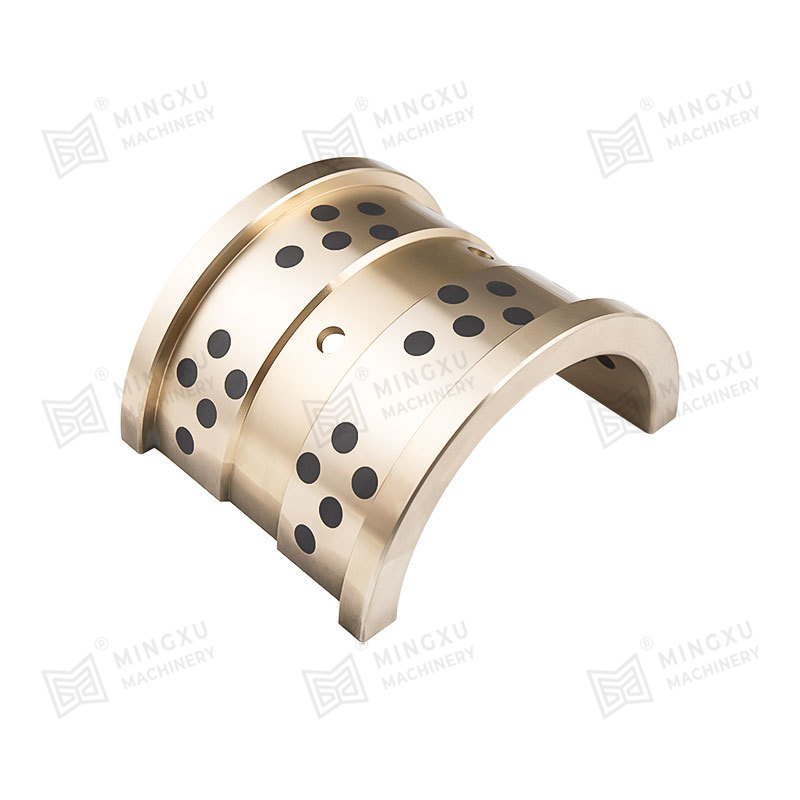MXB-JTWN メートル系スラストワッシャー ねじ穴なし
Cat:自己潤滑ベアリング
MXB-JTW メートル スラスト ワッシャーは高強度黄銅 (ZCuZn25Al6) をベースにしており、従来の錫青銅に代わる潤滑媒体としてマトリックスに固体潤滑剤 (グラファイトまたは二硫化モリブデン) が埋め込まれています。この製品は、信頼性が高く効率的な負荷分散を実現し、車両のトランスミ...
詳細を見るSelf-lubricating bushings are designed to operate in environments where traditional lubricated systems might struggle, including areas with high contamination like dust, dirt, or other particulates. Here's how they perform in these challenging conditions:
Self-Lubricating Mechanism in Contaminated Environments
Self-lubricating bushings use materials such as porous metals, composites, or solid lubricants (e.g., PTFE or graphite) that allow them to maintain low friction without relying on external liquid lubricants. These materials are beneficial because:
Solid Lubricants: Many self-lubricating bushings incorporate solid lubricants like PTFE or graphite, which are embedded within the material and can migrate to the surface under friction. These lubricants are not easily displaced or contaminated by dust or dirt, allowing the bushing to maintain performance even in harsh conditions.
Porous Materials: The porous structure of some self-lubricating bushings (e.g., sintered metal bushings) allows them to store and release lubricants. Even if dust or dirt infiltrates the pores, the internal lubricant often remains protected, and the bushing can continue to operate effectively.
Resistance to Abrasive Particles
One of the biggest challenges in high-contamination environments is the wear caused by abrasive particles like dirt and dust. Here’s how self-lubricating bushings handle this:
Reduced Wear: Since the lubricant (e.g., PTFE) is embedded in the bushing material itself, there is a constant supply of lubrication to the contact surfaces. This reduces the friction between the moving parts, minimizing the abrasive wear that would otherwise occur in a dry or poorly lubricated system.
Harder Materials: Many self-lubricating bushings are made from tough, wear-resistant materials (like bronze, steel, or advanced composites), which helps them resist the abrasive effects of dirt and dust.
Self-Healing Lubrication: Solid lubricants like PTFE or graphite have the ability to "heal" the worn surfaces by migrating from the bushing to the interface, even if dirt or debris is present. This self-regenerating feature makes them highly effective in contaminated environments.
Impact of Contaminants on Traditional Lubrication Systems
In contrast to traditional bushings that rely on external liquid lubricants, which are vulnerable to contamination:
Oil or Grease Contamination: In standard bushings, dirt or dust can mix with the lubricants, causing clogs, sludge, or the breakdown of the lubricant’s effectiveness. This can result in increased friction, premature wear, and system failure.
Loss of Lubrication Efficiency: External lubricants can wash away or be displaced by contaminants, reducing their ability to create a lubricating film and potentially leading to metal-to-metal contact, which accelerates wear.
Self-lubricating bushings, by contrast, are designed to withstand these contaminants without the same level of performance degradation.

Sealing Capabilities
In some self-lubricating bushing designs, integrated seals or the bushing material itself can provide additional protection from dirt and debris. The seals prevent contaminants from entering the internal lubricant storage areas, ensuring that the lubrication system remains effective. The self-lubricating material can also help to prevent the accumulation of dirt on the surface, maintaining smooth operation.
Durability and Lifespan
Self-lubricating bushings often exhibit longer service life in contaminated environments compared to traditional bushings because of:
Reduced Friction: Less friction means less heat and wear, which helps the bushing last longer even under abrasive conditions.
Less Maintenance: Since the lubrication is embedded in the bushing material, the need for regular lubrication replenishment or cleaning of contaminants is minimized, reducing maintenance efforts and downtime.
Applications in High-Contamination Environments
Self-lubricating bushings are commonly used in applications where dirt, dust, or other particles are prevalent, such as:
Agricultural Equipment: Bushings in machinery exposed to soil, sand, and debris.
Construction Machinery: Heavy-duty equipment like excavators and bulldozers operating in dusty, dirty environments.
Mining Equipment: Components that work in environments with significant dirt, mud, and abrasive particles.
Automotive and Off-Road Vehicles: Suspension systems and other parts that are exposed to dirt and gravel.
Limitations and Considerations
While self-lubricating bushings perform well in high-contamination environments, there are some limitations to consider:
Extreme Contaminant Load: Very high levels of dust, dirt, or other debris can still impact performance if the contaminants overwhelm the self-lubricating mechanism. For example, an excessive buildup of particulate matter might reduce the lubricant's ability to migrate to the contact surface.
Abrasion Resistance: While self-lubricating materials are designed to resist abrasion, extreme contamination (e.g., hard or sharp particles) may still cause wear over time, especially in applications where very high loads are involved.

MXB-JTW メートル スラスト ワッシャーは高強度黄銅 (ZCuZn25Al6) をベースにしており、従来の錫青銅に代わる潤滑媒体としてマトリックスに固体潤滑剤 (グラファイトまたは二硫化モリブデン) が埋め込まれています。この製品は、信頼性が高く効率的な負荷分散を実現し、車両のトランスミ...
詳細を見る
MXB-JDBUF 自己潤滑性鋳造ブロンズベアリングは、自己潤滑性とフランジ設計の利点を組み合わせています。原材料は高品質の鋳造青銅材で作られており、耐久性、耐摩耗性、耐食性を確保しています。埋め込まれた固体潤滑剤(グラファイトなど)は自己潤滑特性を備えているため、追加の潤滑の必要がなく、メン...
詳細を見る
鉱山機械で使用される機器は、深刻な磨耗や損傷を受ける可能性があります。機器の耐用年数を延ばすために、MXB-JTSW 耐摩耗鋼板がよく使用され、ライニングを作成して損傷した機械を保護し、機器の磨耗を遅らせ、機器の耐用年数を延ばします。鉱山機械では、装置のライニング プレートとして MXB-JT...
詳細を見る
MXB-JOML 自己潤滑摩耗プレートは、産業用途での摩擦を最小限に抑え、耐用年数を延ばすように設計されています。この製品は高性能材料の切削ブレンドで作られており、優れた耐荷重能力、摩擦の軽減、耐久性の向上を実現しています。 MXB-JOML 摩耗プレートは、荷重下で優れた耐摩耗性を提供し、自...
詳細を見る
MXB-JSP 自己潤滑性耐摩耗プレートは、射出成形機、自動車用プレス金型、タイヤ金型、工場機械 (掘削機など) などに適しており、原料として銅合金を使用し、自己潤滑性を実現するために黒鉛インレイを使用しています。効果、2/3/4/5/6/8/10 ネジ穴直径をお選びいただけます。
詳細を見る
高品質のグラファイト銅合金から構築されたMXB-JSL Lタイプの自己潤滑ガイドレールは、金型アセンブリ内の金型クランプガイドの軌跡に戦略的に設置されています。この位置の精度は、正確なガイド潤滑を可能にし、上部および下部金型の関与の重要な段階で実質的な圧力耐性を提供するために重要です。傑出した...
詳細を見る
円形ガイドは自動車パネル金型や大型プレス金型によく使用されます。モールドベースとアンロードプレートのガイドには、通常、自己潤滑性のガイドブッシュが使用されます。多くの輸出金型では、より高水準の NAAMS ガイドの使用が必要です。セット、金型加工はNC化され、加工精度と製造技術が安定し向上しま...
詳細を見る
MPW VDI3357 標準ウェアプレートは、特殊な固体潤滑剤を適切な位置に注入して作られています。金属母材が荷重を支持し、固形潤滑剤が埋め込まれているため潤滑効果があります。過酷な条件下でも良好な自己潤滑耐久性を発揮します。頻繁に給油が必要な場所、往復運動や起動停止が頻繁な場所、油膜が形成さ...
詳細を見る
SF-1X無給油潤滑軸受は、鋼板をベースとし、その中心に球状の青銅粉末を焼結し、表面にポリテトラフルオロエチレン(PTFE)と鉛の混合物を圧延した転がり滑り軸受です。摩擦係数が小さく、耐摩耗性、耐食性に優れ、オイルフリー潤滑が可能な特性を持っています。この製品を使用すると、コスト削減、機械容積...
詳細を見る
SF-1D油圧軸受はSF-1Pをベースに設計され、オイルシリンダとショックアブソーバの動作原理を組み合わせた新しいタイプの油圧軸受です。オイルフリーの状態ではより耐摩耗性が高くなります。 SF-1Pの利点に加えて、この製品は、頻繁な往復運動や大きな横力がかかる場面に特に適しています。性能は海外...
詳細を見る
お問い合わせ